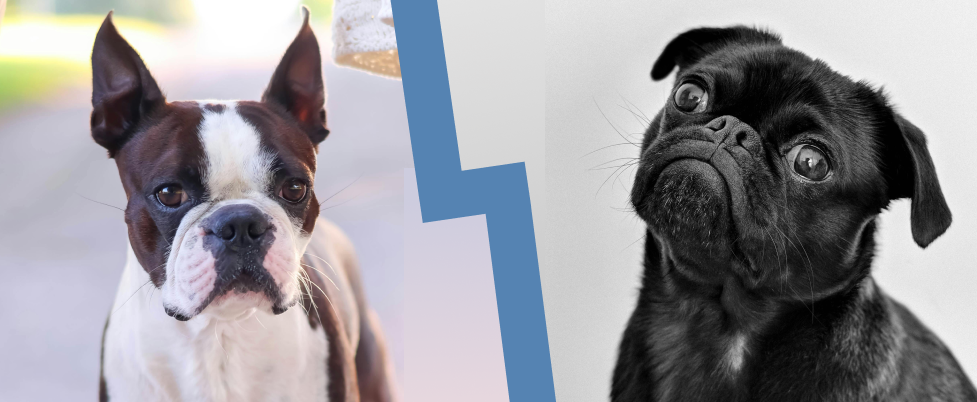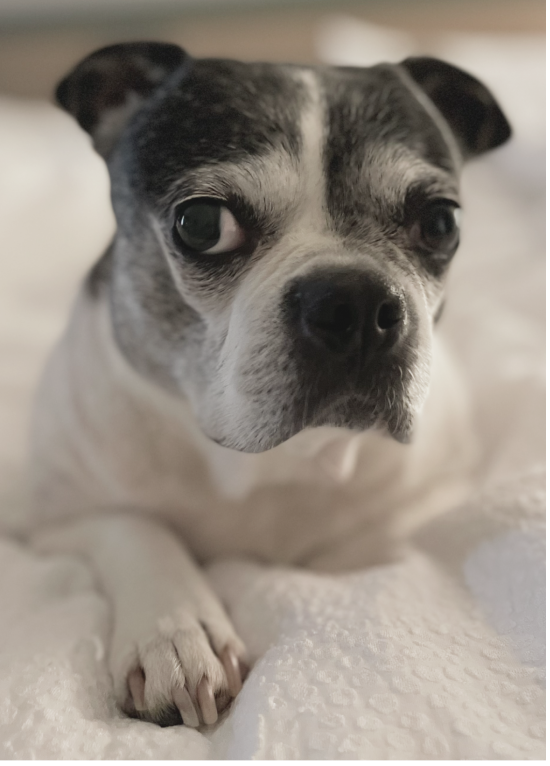BOSTON TERRIER MIXES

Disclaimer: I am not a veterinarian. Always consult a professional for guidance specific to your dog’s breed and needs.
Overview: What Is a Boston Terrier Pug Mix?
The Boston Terrier Pug mix, affectionately known as the Bugg dog, is a delightful blend of two beloved breeds: the spirited Boston Terrier and the charming Pug. This hybrid has won the hearts of dog lovers with its compact size, expressive face, and joyful personality. If you’re considering adding a Bugg to your family or want to learn more about this unique designer dog, this comprehensive guide covers everything you need to know, filling in key content gaps for prospective owners.
Breed Origins and History
The Bugg dog is a relatively recent addition to the world of designer dogs, combining the Boston Terrier-a breed known for its tuxedo-like markings and lively disposition-with the Pug, celebrated for its affectionate, comical nature and distinctive wrinkled face45. The goal was to create a small companion dog that embodies the best qualities of both parent breeds.
Appearance: What Does a Boston Terrier Pug Mix Look Like?
- Size: 10–25 pounds, 14–18 inches tall5.
- Build: Sturdy, compact, and muscular.
- Coat: Short, smooth, and low-shedding; colors include black, brown, white, and tuxedo-like combinations.
- Face: May inherit the Pug’s wrinkles and round eyes or the Boston’s expressive gaze and perky ears.
- Tail: Can be curled (like a Pug) or straight (like a Boston Terrier).
Temperament and Personality
The Bugg dog is renowned for its affectionate, playful, and loyal nature. Here’s what you can expect:
- Family-Friendly: Excellent with children and adults alike; thrives on attention and companionship.
- Playful: Loves games, toys, and interactive play sessions.
- Affectionate: Enjoys cuddling and being close to family members.
- Protective: May be watchful and alert, making them good little watchdogs.
- Trainability: Moderately trainable; can be stubborn, so patience and positive reinforcement are key.
- Sociability: Generally friendly with other pets and people, especially when socialized early.
Activity Level and Exercise Needs
Physical and Mental Needs:
- Moderately Active: Needs daily walks and playtime but not as demanding as high-energy breeds.
- Mental Stimulation: Enjoys puzzle toys and games that challenge their intelligence.
- Indoor Play: Adaptable to apartment living if exercised regularly.
Health and Lifespan
Lifespan
Average Lifespan: 10–15 years, similar to both Boston Terriers and Pugs.
Boston Terriers generally have a lifespan of 11-14 years with an average of 12, Pugs generally have a lifespan of 12-15 years with an average of 13.
Common Health Issues
Bugg dogs can inherit health concerns from both parent breeds. Key issues include:
- Brachycephalic Syndrome: Due to their short snouts, Buggs may experience breathing difficulties, especially in hot or humid weather.
- Eye Problems: Both breeds are prone to eye injuries and conditions due to prominent eyes.
- Patellar Luxation: Knee joint issues are common in small breeds5.
- Obesity: Both Pugs and Boston Terriers gain weight easily, so portion control is essential.
- Skin Fold Infections: Wrinkles can trap moisture and bacteria, leading to irritation.
Preventative Care
- Regular Vet Visits: Early detection of health issues is crucial.
- Weight Management: Feed a balanced diet and avoid overfeeding.
- Dental Care: Brush teeth regularly to prevent dental disease.
- Temperature Sensitivity: Avoid strenuous activity in heat and humidity.
Grooming and Maintenance
- Low Shedding: Short coat requires minimal brushing-once a week is usually sufficient.
- Bathing: Bathe as needed, typically every 1–2 months.
- Wrinkle Care: Clean facial wrinkles regularly to prevent infection.
- Nail and Ear Care: Trim nails and check ears for debris or infection.
Nutrition and Feeding
- Balanced Diet: Choose high-quality dog food formulated for small breeds.
- Portion Control: Monitor weight to prevent obesity, a common issue in both parent breeds.
- Feeding Schedule: Two meals per day for adults; puppies may need three to four smaller meals.
Training and Socialization
Training Tips
- Start Early: Begin training and socialization as soon as your puppy comes home.
- Positive Reinforcement: Use treats and praise to encourage good behavior.
- Consistency: Establish routines for feeding, potty breaks, and training sessions.
- Short Sessions: Keep training sessions brief and fun to maintain your Bugg’s interest.
- Patience: Buggs can be stubborn, so patience and persistence are important.
Socialization
- Expose to New Experiences: Introduce your Bugg to different people, pets, sounds, and environments during the critical socialization window (8–16 weeks.)
- Prevent Fearfulness: Early socialization helps prevent shyness or fear-based behaviors later in life.
Living Environment
- Apartment Friendly: Compact size and moderate exercise needs make Buggs well-suited to apartment living.
- Companionship: Thrive in homes where they receive plenty of attention.
- Not Ideal for Long Alone Time: May develop separation anxiety if left alone for extended periods.
Bugg Dog vs. Other Small Designer Breeds
| Feature | Bugg Boston Terrier/Pug | Frenchton Boston/Frenchie | Bo-Chi Boston Terrier Chihuahua Mix |
| Size | 10–25 lbs | 15–25 lbs | 6–15 lbs |
| Temperament | Playful, affectionate | Playful, loving | Playful, Loyal, lively |
| Coat | Short, low-shedding | Short, smooth | Short, silky |
| Exercise Needs | Moderate | Moderate | Moderate |
| Good with Kids | Yes | Yes | Sometimes |
Content Gaps: What Prospective Owners Need to Know
1. Behavioral Challenges
Buggs can inherit stubbornness from the Pug side, making training a test of patience. Early, consistent training and socialization are essential to prevent unwanted behaviors like excessive barking or willfulness
2. Allergy Considerations
While Buggs are low-shedding, they are not hypoallergenic. Prospective owners with allergies should spend time with the breed before committing.
3. Travel and Lifestyle
Buggs adapt well to travel and new environments if socialized early. However, their brachycephalic features mean they should never be left in hot cars or exposed to extreme temperatures
4. Rescue and Adoption
Buggs are becoming more common in rescues and shelters. Adoption is a wonderful option and can save a life
5. Insurance and Veterinary Costs
Because of their potential for health issues, especially respiratory and eye problems, owners should budget for possible veterinary expenses and consider pet insurance.
Frequently Asked Questions
Are Boston Terrier Pug mixes good with children?
Yes, Buggs are typically very friendly and affectionate with children, making them excellent family pets.
How much exercise do Buggs need?
They require moderate daily exercise-about 30 minutes of walks and playtime.
Are Buggs easy to train?
They are moderately trainable but can be stubborn. Positive reinforcement and consistency are key.
How long do Buggs live?
The average lifespan is 10–15 years, with proper care and a healthy lifestyle.
Do Buggs shed a lot?
No, they are low-shedding and require minimal grooming.
Conclusion
The Boston Terrier Pug mix, or Bugg dog, is a lovable, playful, and affectionate hybrid that makes a wonderful companion for families, singles, and seniors alike. With their compact size, friendly nature, and moderate care needs, Buggs adapt well to a variety of living situations. However, prospective owners should be aware of potential health issues, training challenges, and the importance of early socialization.
If you’re seeking a loyal, fun-loving dog with a big personality in a small package, the Bugg could be the perfect addition to your home.For more information on responsible dog ownership and breed standards, visit the American Kennel Club and Pug Breed Information.
Other articles by this author

“Hi! I’m Weezie, a spirited Boston Terrier / French Bulldog mix and self-proclaimed expert on everything Boston.